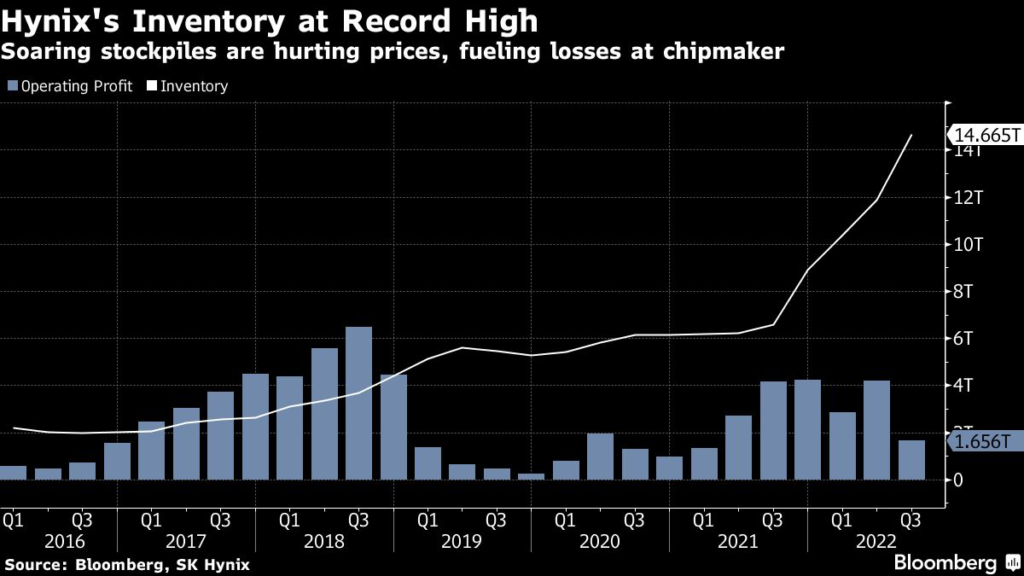SK Hynix Inc. stuck with plans to halve 2023 capital spending after reporting its biggest quarterly loss on record, hammered by a historic chip industry slump.
(Bloomberg) — SK Hynix Inc. stuck with plans to halve 2023 capital spending after reporting its biggest quarterly loss on record, hammered by a historic chip industry slump.
Slammed by a more than 50% slide in memory chip prices from a recent peak, the Apple Inc. supplier said Wednesday it is slashing output, capex and costs as it awaits a recovery in the second half of the year.
The world’s No. 2 DRAM maker reported a deeper-than-expected operating loss of 1.7 trillion won ($1.4 billion) for the three months ended in December on a 38% drop in revenue.
Despite rivals Micron Technology Inc. and Kioxia Holdings Corp. also cutting output, sector-wide inventory levels will keep growing, hitting a peak in the first quarter, before gradually falling towards the bottom half of the year, executives said. Hynix’s larger rival Samsung Electronics Co. had earlier dashed hopes for a large pullback in 2023 supply by saying it would keep capex at 2022’s level.
For now, pricing pressure on Hynix will continue, as demand for consumer electronics weakens and customers destock inventory, said Bloomberg Intelligence credit analyst Cecilia Chan. “SK Hynix is likely to see operations deteriorate further into 2023.”
Shares of Hynix pared earlier gains and were up around 0.5% during Wednesday morning trade in Seoul.
For months, the $160 billion memory industry has been reeling from a large imbalance between supply and demand. Memory makers are sitting on three to four months’ worth of inventory, while clients have yet to use up their stockpiles. South Korea’s exporters have been hitting the brakes in response to slumping consumer spending worldwide. The country’s exports declined 17% in January from a year earlier, largely due to a 44.5% drop in semiconductor exports.
Hynix especially has been saddled by an outsize amount of inventory. An acquisition of Intel Corp.’s flash memory business — since renamed Solidigm — has contributed to Hynix’s inventory piling up faster than those of its peers.
“Hynix’s soaring inventory caused a decline in its memory prices that exceeded market expectations,” said Nam Dae-jong, analyst at eBest. Its inventory will remain high for the rest of the year, Nam said, adding the company needed to actively adjust capacity.
Hynix has devoted years to turning around its NAND business. It sought to solidify its market share and improve profitability through the acquisition of Solidigm’s technology and factories, which includes facilities in China. The unit has since faced multiple challenges, including slumping demand and tighter US sanctions against tech exports to China.
The downturn is not just a function of volatility in memory, said Myoungsoo Park, head of DRAM Marketing at Hynix. The semiconductor market now reflects “a more broad and persistent volatility in the macro-environment that is now compounded by geopolitical issues,” he said.
The market will improve gradually, helped by China’s reopening and a recovery for mobile gadgets in the second half of the year, Hynix said. But for the full year, wafer output for both DRAM and NAND will likely fall from the previous year, it said.
“Our customers are saying they are seeing stronger demand momentum compared to the year prior,” Park said, referring to a projected pickup in data center demand. “That is an opportunity the company cannot miss.”
–With assistance from Ville Heiskanen.
(Updates with comments from analyst and executives from fifth paragraph)
More stories like this are available on bloomberg.com
©2023 Bloomberg L.P.










